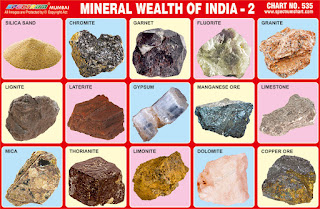 |
| Mineral Wealth of India 2 Chart |
Spectrum Chart - 535 : Mineral Wealth of India 2
1. Silica Sand – Silica sand is the sand
found on a beach and is also the most commonly used sand. It is made
by either crushing sandstone or taken from natural occurring
locations, such as beaches and river beds. Silica sand is the most
commonly used sand because of its great abundance and low cost.
2. Chromite - Chromite is an iron chromium
oxide. It is an oxide mineral belonging to the spinel group. It is by
far the most industrially important mineral for the production of
metallic chromium, used as an alloying ingredient in stainless and
tool steels. The chromium extracted from chromite is used in chrome
plating and alloying for production of corrosion resistant
superalloys, nichrome and stainless steel. It is also sometimes used
as a gemstone.
3. Garnet – Garnets are a group of
silicate minerals that have been used since the Bronze Age as
gemstones and abrasives. There are many different kinds of garnets,
containing different metals. Crystals of garnet are often large and
pretty. Their most common colour is red or purple, but they can be
found in almost all colours and are often used in jewellery.
4. Fluorite - Fluorite is a mineral made
up of calcium and fluoride or calcium fluoride. It can come in every
single colour on the colour spectrum. Pure fluorite is colourless. When
fluorite is coloured it is because of various impurities. Fluorite
glows when it is exposed to UV light. Because of its soft texture,
fluorite is used in carving.
5. Granite - Granite is one of the most
common rocks on Earth, and is the most common igneous rock. This
dense stone is used in construction, for everything from basic
building to beautiful polished countertops.
6. Lignite - Lignite, often referred to as
brown coal, is a soft brown combustible sedimentary rock formed from
naturally compressed peat. It is considered the lowest rank of coal
due to its relatively low heat content. It has a carbon content
around 60-70%. It is mined all around the world and is used almost
exclusively as a fuel for steam-electric power generation.
7. Laterite - Laterite is a soil and rock
type rich in iron and aluminium and is commonly considered to have
formed in hot and wet tropical areas. Nearly all laterites are of
rusty-red coloration, because of high iron oxide content. Laterites
are a source of aluminium ore. The majority of the land area
containing laterites is between the tropics of Cancer and Capricorn.
8. Gypsum – Gypsum is a soft sulfate
mineral composed of calcium sulfate dihydrate. It is widely mined and
is used as a fertilizer and as the main constituent in many forms of
plaster, blackboard chalk and wallboard. Gypsum is a main ingredient
in plaster of Paris which is used to make casts and sculptures.
Gypsum is also used to make cement and paint fillers.
9. Manganese Ore - Manganese is a
silvery-grey metal and is part of the group known as the transition
metals. It is hard and very brittle, difficult to fuse, but easy to
oxidize. Manganese is a metal with important industrial metal alloy
uses, particularly in stainless steels.
10. Limestone - Limestone is a sedimentary
rock composed largely of the minerals calcite and aragonite, which
are different crystal forms of calcium carbonate (CaCO3). Limestone
is very common in architecture. Many landmarks across the world,
including the Great Pyramid are made of limestone.
11. Mica – The mica group of sheet
silicate minerals includes several closely related materials having
nearly perfect basal cleavage. Mica is stable when exposed to
electricity, light, moisture and extreme temperatures. It has
superior electrical properties as an insulator and as a dielectric
and can support an electrostatic field while dissipating minimal
energy in the form of heat.
12. Thorianite – Thorianite is a rare
thorium oxide mineral. It was so named on account of its high
percentage of thorium, it also contains the oxides of uranium,
lanthanum, cerium, praseodymium and neodymium. It is slightly less
radioactive than pitchblende, but is harder to shield due to its high
energy gamma rays.
13. Limonite – Limonite is an iron ore
consisting of a mixture of hydrated iron(III) oxide-hydroxides in
varying composition. Limonite is relatively dense with a specific
gravity varying from 2.7 to 4.3. It varies in colour from a bright
lemony yellow to a drab greyish brown. Limonite is one of the two
principal iron ores, the other being hematite and has been mined for
the production of iron since at least 2500 BCE.
14. Dolomite - Dolomite is a mineral and a
rock that has a unique saddle-shaped crystal. It is made up of
calcium magnesium carbonate and most likely exists in sedimentary or
metamorphic rocks. Dolomite can be found in large, thick areas called
dolomite beds. Dolomite is used in the manufacturing of bricks that
are used to produce steel.
15. Copper Ore - Copper
is an element and a mineral. It is found in the oxidized zones of
copper deposits in hydrothermal veins, in the cavities of basalt and
as pore fillings and replacements in conglomerates. It is rarely
found in large quantities. Most copper produced is extracted from
sulfide deposits. Most copper mined today is used to conduct
electricity - mostly as wiring.

No comments:
Post a Comment